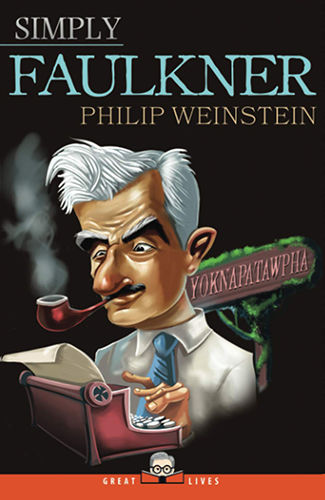Becoming Faulkner: The Art and Life of William Faulkner
- Philip Weinstein

- Mar 8, 2022
- 4 min read
Updated: Mar 17, 2022
Read an excerpt below:
None of these chapters scrupulously respects chronological order (although my narrative does advance—erratically—in time). Instead each chapter, entering the life at a moment of sudden or cumulative stress, stays with the dynamics and fallout of that stress in ways no biography committed to progressing responsibly from 1897 to 1962 can afford to do. In this sense, I seek to “compose Faulkner,” rearranging the materials of his life and art so as to seize on latent patterns within a larger troubled weave. I “compose” him in another sense as well. I pretend now and then to “become Faulkner,” to narrate—as subjective experience not seen past or later diagnosed—some of his moment-by-moment dilemmas. In these vignettes I seek less to recuperate the life into meaning than to articulate it as process, to fashion—and pass on to my reader—something resembling its turbulent texture. Although the biographical data buttressing these simulations are well established, such sequences involve—of course—invention on my part. I am not so naïve as to believe that I could actually “become Faulkner”! My aim is heuristic: to simulate (at crucial instances) the precious life-reality that escapes all biographies—what it might have felt like to be Faulkner, in present time and cascading trouble. Invention, then, not for its own sake, but to put flesh on the primary bones of my argument: that unmanageable trouble in time emerges as the fault line joining Faulkner’s discretely disturbed life with his inexhaustibly disturbing novels.

This book and others by Philip Weinstein are available for purchase on Amazon.
Editorial Reviews
"In an earlier study, Weinstein offered the lapidary observation that Faulker 'was hurt into greatness.' Becoming Faulkner elaborates powerfully, and often brilliantly, on that claim...Along the way we are treated to breathtaking flashes of insight."
The Southern Register
"Philip Weinstein... has written a deeply felt, spellbinding, lyrically written tale of Faulkner's art and life, how each bred and interpenetrated the other, a dynamic dialectic of doom and hope, sex and sensibility, Southern myth and personal agonies."
Providence Journal
"Becoming Faulkner gives Faulkner's readers a powerfully original account of how the author's tortured but fiercely guarded personal life informed his creative one. Weinstein brilliantly renders Faulkner's struggles with unconquerable difficulties-family disasters and doomed loves, the maelstrom of Southern racial conflict, flights toward self-destruction, the intolerability of success-to provide an unprecedented and invaluable affective life of the writer."
John Matthews, Boston University
"Intricately weaving together the intense struggles that Faulkner confronted in a life fraught with personal and cultural conflicts with the works of genius he produced both out of, and in the face of, those conflicts, Becoming Faulkner is brave, bold, and brilliant. Weinstein's unorthodox approach to Faulkner's life and art delivers a stunningly original grasp of both. A landmark book in Faulkner Studies."
Carolyn Porter, University of California, Berkeley
"Faulkner has a reputation of being a writer difficult to read and understand, yet in this wonderfully illuminating book, Philip Weinstein shows us a way in. By revealing how Faulkner's writing is a uniquely faithful rendering of human life as it is actually lived rather than as it is usually written about, Weinstein explains why Faulkner-a man of terrifying openness-invented a whole new way of writing to capture trouble as it is being experienced, before we can grasp its significance. Seen from this perspective, Faulkner's novels take on sudden clarity. Everyone who reads fiction, as well as all Faulkner lovers, will not want to miss this remarkable book."
Carol Gilligan, author of In a Different Voice and Kyra
"Weinstein acknowledges that although Faulkner would have protested this glimpse into his tormented private world, he also would have recognized the portrait as true. What more can one ask of a biographer? This rich work will be well received by Faulknerian students and scholars. Highly recommended."
Library Journal
"At a time when over-stuffed biographies and specialist criticism have left our major literary figures more dissected than understood, Weinstein gives us his most profound, ambitious, and loving work, a book that captures the Faulkner that matters-the mess of the life caught up inextricably with the power of his novels. Whether you've read Faulkner, or studied him, or simply always wanted to grasp his importance to American literature, Becoming Faulkner offers as rich and pleasurable a journey into his great achievements as you'll ever find."
Adam Haslett, author of You Are Not a Stranger Here and Union Atlantic
"Writing," says Weinstein, near the end of this thoughtful book, "was how Faulkner reckoned with what had happened to him in life." He experienced as drama the endless contradictions and contrarieties that merged in his consciousness, translating them into prose that outlasted him. The task of making fiction was inextricably linked with the process of "becoming Faulkner"; serious readers of Faulkner will be grateful to Weinstein for what he tells us about this strange, often painful, process."
American Scholar
"Becoming Faulkner delivers what we all want but so seldom get from a literary biography: genuine insight into how its subject's life engendered great work. It is critically persuasive, concisely informative, admirable in its balancing of sympathy and judgment, and thoroughly enjoyable to read."
Jonathan Franzen, author of Freedom










Comments